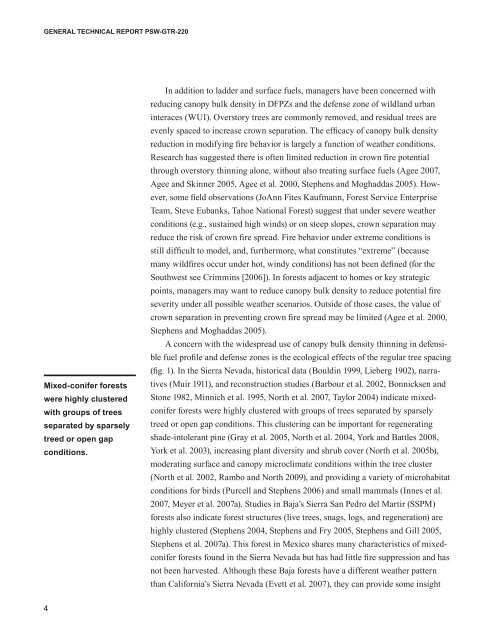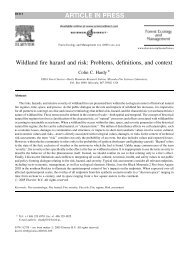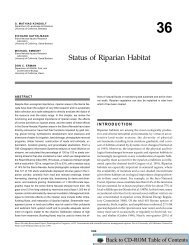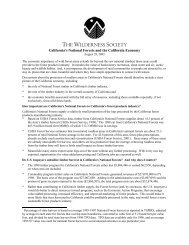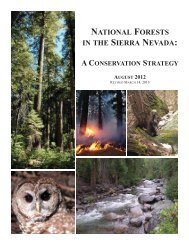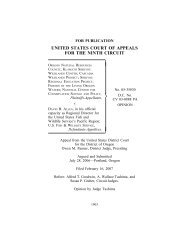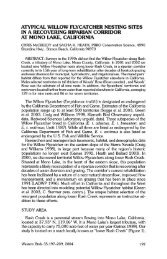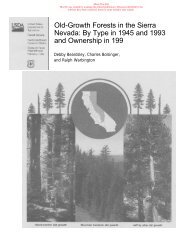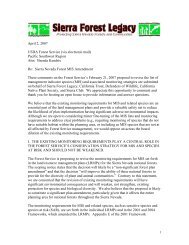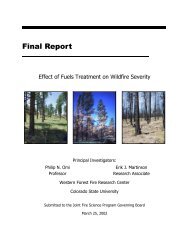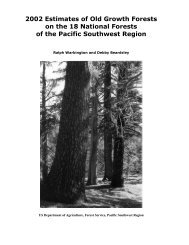An Ecosystem Management Strategy for Sierran Mixed-Conifer Forests
An Ecosystem Management Strategy for Sierran Mixed-Conifer Forests
An Ecosystem Management Strategy for Sierran Mixed-Conifer Forests
You also want an ePaper? Increase the reach of your titles
YUMPU automatically turns print PDFs into web optimized ePapers that Google loves.
GENERAL TECHNICAL REPORT PSW-GTR-220<br />
<strong>Mixed</strong>-conifer <strong>for</strong>ests<br />
were highly clustered<br />
with groups of trees<br />
separated by sparsely<br />
treed or open gap<br />
conditions.<br />
In addition to ladder and surface fuels, managers have been concerned with<br />
reducing canopy bulk density in DFPZs and the defense zone of wildland urban<br />
interaces (WUI). Overstory trees are commonly removed, and residual trees are<br />
evenly spaced to increase crown separation. The efficacy of canopy bulk density<br />
reduction in modifying fire behavior is largely a function of weather conditions.<br />
Research has suggested there is often limited reduction in crown fire potential<br />
through overstory thinning alone, without also treating surface fuels (Agee 2007,<br />
Agee and Skinner 2005, Agee et al. 2000, Stephens and Moghaddas 2005). However,<br />
some field observations (Jo<strong>An</strong>n Fites Kaufmann, Forest Service Enterprise<br />
Team, Steve Eubanks, Tahoe National Forest) suggest that under severe weather<br />
conditions (e.g., sustained high winds) or on steep slopes, crown separation may<br />
reduce the risk of crown fire spread. Fire behavior under extreme conditions is<br />
still difficult to model, and, furthermore, what constitutes “extreme” (because<br />
many wildfires occur under hot, windy conditions) has not been defined (<strong>for</strong> the<br />
Southwest see Crimmins [2006]). In <strong>for</strong>ests adjacent to homes or key strategic<br />
points, managers may want to reduce canopy bulk density to reduce potential fire<br />
severity under all possible weather scenarios. Outside of those cases, the value of<br />
crown separation in preventing crown fire spread may be limited (Agee et al. 2000,<br />
Stephens and Moghaddas 2005).<br />
A concern with the widespread use of canopy bulk density thinning in defensible<br />
fuel profile and defense zones is the ecological effects of the regular tree spacing<br />
(fig. 1). In the Sierra Nevada, historical data (Bouldin 1999, Lieberg 1902), narratives<br />
(Muir 1911), and reconstruction studies (Barbour et al. 2002, Bonnicksen and<br />
Stone 1982, Minnich et al. 1995, North et al. 2007, Taylor 2004) indicate mixedconifer<br />
<strong>for</strong>ests were highly clustered with groups of trees separated by sparsely<br />
treed or open gap conditions. This clustering can be important <strong>for</strong> regenerating<br />
shade-intolerant pine (Gray et al. 2005, North et al. 2004, York and Battles 2008,<br />
York et al. 2003), increasing plant diversity and shrub cover (North et al. 2005b),<br />
moderating surface and canopy microclimate conditions within the tree cluster<br />
(North et al. 2002, Rambo and North 2009), and providing a variety of microhabitat<br />
conditions <strong>for</strong> birds (Purcell and Stephens 2006) and small mammals (Innes et al.<br />
2007, Meyer et al. 2007a). Studies in Baja’s Sierra San Pedro del Martir (SSPM)<br />
<strong>for</strong>ests also indicate <strong>for</strong>est structures (live trees, snags, logs, and regeneration) are<br />
highly clustered (Stephens 2004, Stephens and Fry 2005, Stephens and Gill 2005,<br />
Stephens et al. 2007a). This <strong>for</strong>est in Mexico shares many characteristics of mixedconifer<br />
<strong>for</strong>ests found in the Sierra Nevada but has had little fire suppression and has<br />
not been harvested. Although these Baja <strong>for</strong>ests have a different weather pattern<br />
than Cali<strong>for</strong>nia’s Sierra Nevada (Evett et al. 2007), they can provide some insight<br />
4


